Impact of NoFollow 2.0, UGC and Sponsored Link Attributes
Auch verfügbar in Deutsch: Auswirkung der neuen NoFollow 2.0, UGC und SPONSORED LinksTable of Contents
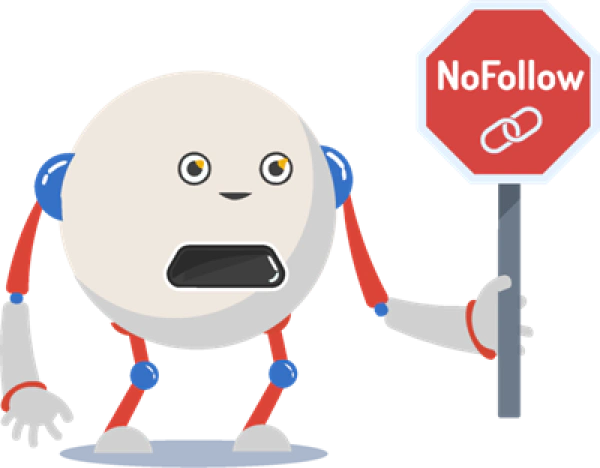
Impact of NoFollow 2.0, UGC and Sponsored Link Attributes #
What the NoFollow Links 2.0 change means #
Right for the tenth birthday of LRT on 9/9/19, we get a surprise notice from Google that they change the way they handle links.
NoFollow links may affect your rankings. Now for sure, once for all.
[NoFollow Links are handled different starting Sept 10, 2019.]3
After 15 years Google now introduced two new link tags
- “UGC” - for user-generated content, i.e., random people adding links to a website’s content
- “SPONSORED” for webmasters selling links to advertisers
to give more detail to the intent and origin of a link.
You might see unexpected link effects positive and negative as Google starts to count nofollowed links now.
Links from sites that implemented a nofollow link policy as a blanket rule before can affect you, when they did not before.
How it all began with NoFollow Links #
Initially, Google kept saying that the tag “NOFOLLOW” should be used on links we don’t trust. They also said that the NoFollow attribute would be seen as a strong recommendation not to count the link, at all. Sometimes even 100% assertive that the NoFollow would exclude the link from any calculations. Google, Bing (MSN back then) and Yahoo (that had their search index corpus back then, not the one from Bing) agreed that something had to be done to combat blog comment spam, and invented the
rel="nofollow"
attribute that is used in links like this
<a rel="nofollow" href="https://moneysite.com">Money Keyword</a>
Some people also called it the “link condom”, but that’s another story.
Why care about NoFollow 2.0? #
You might see unexpected link effects positive and negative as Google starts to count nofollowed links now.
Links from sites that implemented a nofollow link policy as a blanket rule before can affect you, when they did not before.
The nofollow link attribute has been a staple of the SEO industry for almost 15 years, and now it is changing for the first time, in a big way.
How the NoFollow Links became unreliable #
Fast forward fifteen years, the NOFOLLOW tag is being found in many prominent places that are very far from just blog spam, like
- Newspaper content - many articles nofollow every single link from the body content after guest writers of Forbes and other big ones were “caught” for selling links in their articles by the thousands
- Website navigation - many webmasters and SEOs still swear by the power of “PageRank sculpting” and indexing control by adding the “NoFollow” tag on internal navigation. However back in June 2009 Google’s Matt Cutts already confirmed that this would make the internal link power “disappear.”
- User profile links (UGC) heavily spammed for 15 years, despite NOFOLLOW tags, forums and other community software was suffering more and more from automated link spamming, still in 2019
- Comment links (UGC) - of course, heavily spammed for 15 years, despite NOFOLLOW tags, and all the link spamming software and services and updated, well maintained and sold still in 2019 as I could confirm with some test buys just this summer.
- Highly reputable resources like Wikipedia - which in theory classifies as UGC as well, is pretty heavy policed still, more in German than in English for example, but still. From our perspective these links counted already in many cases for high profile sites link Wikipedia.
- random websites that just clicked the wrong buttons in their “Premium Wordpress Plugin” or were just so scared about getting the penalty that they nofollow’ed all the links regardless - internal and external.
- some scared link sellers that received a Google penalty for outgoing links
- a couple more link sellers where the link buyers (maybe) received a Google penalty for buying links - or the high likelihood
But NOT the majority of link sellers and link buyers, which are Google’s biggest enemies still, when it comes to the manipulation of the search engine results.
Paid links are clearly labelled as “black hat” and Google has declared war on paid links on them more than 16 years ago I believe.
And when it comes to the PageRank Sculpting:
oh yeah, but this calls for a broader discussion on knowledge.
People use nofollow internally because they „read somewhere that it helps to rank certain websites better"
The blogposts about PR sculpting are at least 10 years old, but people still find them and tend to think they just found a gold mine and a secret SEO ingredient 🙂
NoFollow Links were not used for paid links #
Of course over the years more and more link buys were marked as NoFollow... but I would estimate that these were only a very small fraction of paid links were actually marked with the “rel=NoFollow” tag at all, maybe 0.00001% or 1 millionth of all paid links over the years… if so many at all.
There are of course rare exceptions like the paid links on SEroundtable.com - a website that is just to visible to continue sponsored links without the Nofollow tag, especially after the Google penguin updates came.
NoFollow Links caused penalties #
What we have seen and analyzed in very much detail is that links with the NOFOLLOW tag were even mentioned as the cause for penalties. Google penalties were given out for the intent to spam, not only for a specific link type ("dofollow" link in that case).
Google also confirmed that NoFollow links can cause penalties and therefore it just makes sense to evaluate their link risk.
Simple binary NoFollow Link interpretation #
Many SEO people didn’t believe our insights that NoFollow links can cause penalties, though. They were therefore equaling NoFollow links with an effect of zero in all cases, regardless.
Because of this (in our opinion wrong) belief, said SEOs also found auditing and disavowing NoFollow links not necessary.
Circa. 50% of the SEO world believed that if it’s a NoFollow marked link, then the link effect was really zero.
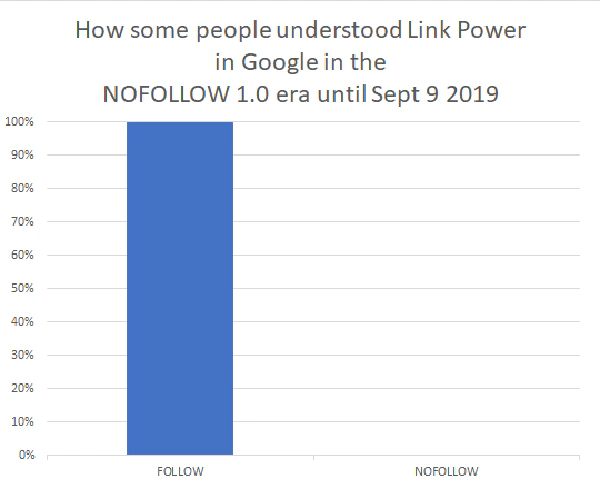 How some people understood Link Power in the NoFollow 1.0 era
How some people understood Link Power in the NoFollow 1.0 era
A simple binary interpretation. Google always said
“NoFollow links don’t pass page rank”
and of course that is easy to understand, easy to explain also for Google to webmasters and SEO.
Passing page rank was not the issue. And this statement was always a wonderful ambiguation with the effects on the rankings of a page, which had little to do with the green public Toolbar PageRank that was useless since latest 2013 and turned off 2016.
This ambiguation was easy, because
- until today Sept 11 2019 even Wikipedia claims that Google would rank it’s pages based on the PageRank algorithm.
- the original page rank paper from 1998 talks about ranking web pages with it, like many of those papers
- it is possible by ignoring many algorithmic filters (like Google Penguin) and “200+ signals (that are of course not known to SEOs, but a lot of possible ones listed here by Brian Dean of Backlinko)” in addition
- the name “PageRank” (by Larry Page of Google) and “a web page ranking” (in search results) being so wonderfully similar… I giggled about this for the last sixteen years.
Point is - Google NEVER said they would completely ignore NoFollow links. And that would be a weird thing to do anyways. We all know that Google loves crawling and hording data, so why would it not make use of this data here - especially given that it may it out to give you a penalty years later.
NoFollow Link hint interpretation #
With all the knowledge about 200 signals and of course Google making their own rules anyways, we also saw
- positive effects of Nofollow (e.g. from Wikipedia which is only nofollowed links).
- negative effects of NoFollow (mentioned link penalties for NoFollow links).
To us it was very clear that Google would not simply interpret the NoFollow tag as a binary “directive” as some SEOs called them now recently.
Nofollow was never an as hard directive as robots.txt directives. And even those directives in robots.txt are ignored by Google at times at their own discretion. And while we’re at it - it’s time to remove that unofficial robots.txt directive that Google supported for a short while, as they decided to not support in anymore since Sept 1 2019.
Google also clearly advised against using NoFollow tags for internal use, indexing control, again, like they did in Jun 2009 at SMX Advanced Seattle when this practice was called “PageRank Sculpting” and not “Crawl Budget Optimization”. Both however have to do with how much resources Google assigns to keeping a website in their index.
50% of SEOs always analyzed NoFollows #
The other half of the SEO world followed the belief and advice that of course Google would crawl and interpret the NoFollow links in some ways. Then depending on what they found attributed some value to it.
This was just recently confirmed in a Twitter poll, which even ended in 65+% pro-nofollow crawls.
https://twitter.com/cemper/status/1153286798979805184
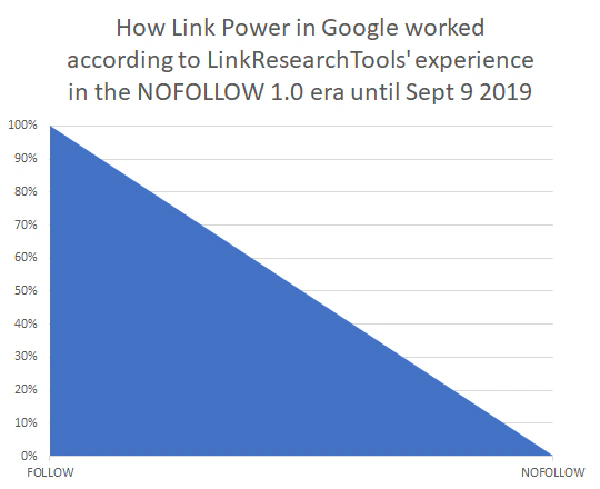 How Link Power in Google worked according to LinkResearchTools experience in the NoFollow 1.0 era
How Link Power in Google worked according to LinkResearchTools experience in the NoFollow 1.0 era
Our idea is that a link is connection from a source to the target, and that we at LRT need to look at both ends of a link just as it appears Google is doing it.
But since there was no clear agreement on NoFollows in the industry, and so we introduced an option to completely ignore Nofollow links in link audits back in 2014 already.
So when today Google says
When nofollow was introduced, Google would not count any link marked this way as a signal to use within our search algorithms.
we call this a wrong, simplified, PR statement of the past.
And it’s OK Google. Plus:
This has now changed. All the link attributes – sponsored, UGC and nofollow – are treated as hints about which links to consider or exclude within Search. We’ll use these hints – along with other signals – as a way to better understand how to appropriately analyze and use links within our systems.
we call this confirming what actually happened inside, plus adding two new “hints” aka signals.
Why not completely ignore such links, as had been the case with nofollow?
The past official statement was simply to hard to keep alive.
It’s good that it’s finally out in the open.
Thanks Google, no worries - I think many knew all along.
Disavowing NoFollow Links recommended #
The fact that NoFollow links caused penalties are also the reason, why we at LinkResearchTools always recommended to disavow them.
Even if you don’t believe that NoFollow links can do any harm you could disavow them all, right?
So better be safe, than sorry.
Google needs better data. For paid links. #
After fifteen years it was time for Google to suggest the new Link markup to extend the REL=NOFOLLOW to gather more data and become more specific.
And Google wants you to Qualify your outbound links to Google.
Labelling UGC generated links make sense. It will help Google understand better which links come from forums and blog comments of all sorts of new types, although those footprints are quite simple to learn.
Labelling sponsored links as such is the real “fishing operation” here I think.
There are two types of link sellers
- Paid Link Creators: those that build whole website empires, PBNs, site networks off expired networks and such. They typically block all sorts of link analysis tools on their sites, or if they are smart, they don’t create that footprint. But for sure they have never and will NEVER mark their paid, sponsored, bartered, simply unnatural links as “sponsored”.
- Paid Link Brokers: these are selling links off existing “authority sites”. It has happened with hundreds of guest post writers on Forbes, Inc.com, Entrepreneur and other publications. Needless to say, Google didn’t like that, and in the end those magazines NoFollowed every single link, unable to police the link selling. https://twitter.com/matthewbarby/status/902579227345739776
And correctly, those links probably didn’t count for a long time before.
Interesting enough, even today our all inboxes are filled with “Guestposting Pros” that can sell you links on those websites from anywhere between USD 20 and USD 2.000
Better data means more precision for Google.
And they want us to help them by adding those new meta tags to our links. Similar like other schema details that will help understand the web and our backlink profiles better.
The original page “Use rel=“nofollow” for specific links” was replaced by today’s help page on the NoFollow, UGC and Sponsored tag being called “Qualify your outbound links to Google”, which is a a clear call to action for webmasters to help Google.
And Google emphasized that three times in the short post
Using “sponsored” is preferred, but “nofollow” is acceptable.
Alright, at least it’s acceptable to use “nofollow” for paid links. Glad to hear.
For now.
Wait for it, this is going to change.
How Google will collect and train Google Penguin for Sponsored Links #
There will come a time when penalties are handed out and the Google web spam team will demand to switch all sponsored links over to REL=SPONSORED, from a
<a href="https://moneysite.com">Big Money Keyword</a>
to
<a rel="nofollow sponsored" href="https://moneysite.com">Big Money Keyword</a>
…and slow and steady Google will get more people give in.
The pressure will come from the link buyers on the link sellers over time.
And Google can better collect and train their Google Penguin systems.
Judging from what we see today with NoFollow, the following will happen
- First all paid links will be DoFollow
- Then the first link buyer will get a penalty, and will demand it’s paid links switched to “Sponsored”
- That will result in a bunch of links from a website of similar types (e.g. from blog content, money keyword, not older than, always in co-citation with….) being switched over from DoFollow to Sponsored
- If that is not enough signal, the sheer fact that links are changed, i.e. switched over (e.g. past niche edits) will cause Google to flag a whole website as “compromised by link sellers”.
Based on a certain percentage Google can then extrapolate on the rest of the site. There you go.
What will the NoFollow 2.0 mean for my links? #
The following discusses how the link effects will look in the NoFollow 2.0 era.
Scenario “Tune NoFollow up - and Spam down” #
The following scenario “tune up” is an example of how the link power effect for the different link statuses Follow, Nofollow, UGC and Sponsored could look like.
This is how it will be if Google will actually use the two new tags to tune down the effect of UGC and Sponsored links.
How Google will interpret Link Power by what we know for the NoFollow 2.0 era
If Google clearly says that all “Sponsored” links will be weakened, they could turn the effect (closer) to zero. I am not saying it needs to be zero, because an advertiser relation is still interesting relevant information, but it will not help in any ranking manipulation I guess.
Calling all UGC links (which are VERY spammed) sometimes weaker than today’s NoFollow links also make sense. This would combat blog spam and such, once the UGC tags are implemented.
However - in this scenario it would tune up the power of NoFollow links on average.
This would make sense to help all the cases where NoFollow was used randomly on internal links.
It is strongly advised in this scenario, that you audit all NoFollow links, assuming that some of them are now in effect. This could be a good thing, but also a very hurtful thing for your rankings - if those are paid links.
Why? Google confirms NoFollow links can count #
This scenario became even more likely as Gary Illyes confirmed at a conference that the change of the NoFollow 2.0 to an official hint was about the loss of link signal data.
Q: Is Google’s motivation for this change because Google wants to strengthen the link signal in order to get better search results?
A: Gary Illyes’ answer (as relayed by Kenichi):
“Yes. They had been missing important data that links had, due to nofollow. They can provide better search results now that they consider rel=nofollowed links into consideration.”
Source: SearchEngineJournal Sept 13
Scenario “Tune NoFollow down - and Spam up” #
The following scenario “tune down” is an example chart of how the distribution could look like moving forward if Google will actually use the two new tags to tune down the effect of UGC and Sponsored links.
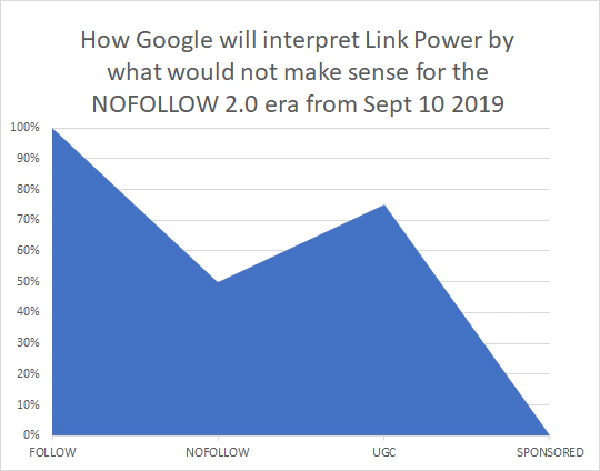 How Google will interpret Link Power by what we know for the NoFollow 2.0 era
How Google will interpret Link Power by what we know for the NoFollow 2.0 era
In this scenario it would tune the effect of the original NoFollows down more, yet keeping them at a higher level than they were, because Sponsored links are the ones who would be weakened more.
The UGC links would be weighted stronger, assuming that spam detection works better for such platforms, depending on the spammed link targets also.
Again in this this case you would need to Audit all NoFollow links, assuming that some of them are now in effect, because the NoFollow seen as hint is not kicking in. This could be a good thing, but also a very hurtful thing for your rankings again.
Scenario “Tune NoFollow to zero” #
The following scenario is completely unlikely. It uses the same chart display but follows the idea that Google would completely ignore NoFollows as a popular belief was for the past years.
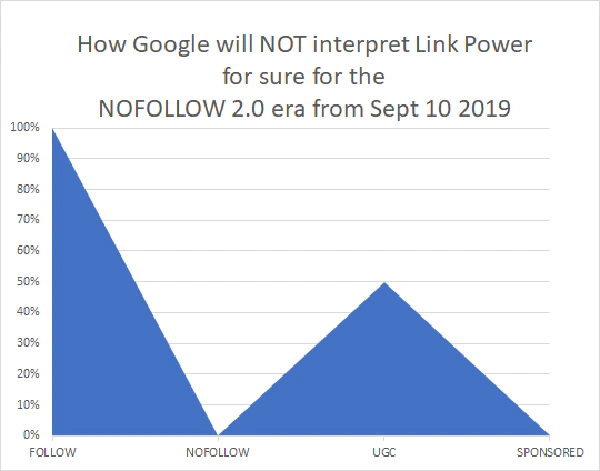 How Google will interpret Link Power by what we know for the NoFollow 2.0 era
How Google will interpret Link Power by what we know for the NoFollow 2.0 era
As Google confirmed now, they certainly take the NoFollow as a hint. And that means they will use it in some cases for sure (like they did in the past).
The message implicit in this, written between the lines of Google’s statement, is that in some cases Google ignores Nofollow, and uses the link signal anyway. They have always done this. Back after Nofollow was introduced, Matt Cutts stated that “if we see a signal is valuable, we can choose to use this”.
I’ll point at Wikipedia as an example. Adoption of the Nofollow attribute sharply reduced spam in that system. What was left were extremely valuable links. Having a link on Wikipedia is valuable for SEO.
Some other networks are also valuable, albeit to lesser degrees. Some types of links on Twitter, Facebook, business directories.
If the links were not valuable, Google would not be making this very mixed message. As Kristine states, there’s otherwise no clear ROI from the viewpoint of web developers and search marketers. On the surface, this only benefits Google. But, if you read between the lines, “hints” mean a passing of PageRank or equivalent values. They’re already using Nofollowed links in some cases. They just want it easier to choose between links to use now in more cases.
In this, and ONLY in this completely unlikely case that would be like the old “binary nofollow belief” it would not make sense to audit NoFollow links at all.
That being said, we may need to change the messaging for this decision better in the future in LinkResearchTools with an “Are you sure to ignore NoFollow links” in this dialog.
And you end up again with the need to do a Link Audit for all your NoFollow links, if you didn’t do that before.
Which NoFollow scenario will be? #
The rules in SEO are not rigid!
As I have been teaching and lecturing since 2008, the rules are different. The weighting of many ranking criteria depends on
- Country,
- Language
- Topic,
- Keyword,
- many aspects more, such as personal search history or Snippet CTR .
So it’s only logical that Google won’t use an overall weighting for the new link signals, but will fine-tune it again.
The rules are different for every keyword. Do your research well.
~Christoph C. Cemper, all the time since 2003.
While Google has announced to support the new link tags immediately, it’s now the webmasters and SEOs turn to implement them. Some webmasters and SEO consultants however are concerned.
I don’t see any reason to use it. No value to my sites. No penalty for using or not using.
IT teams are tired of making changes just because Google says to and I have no business use case to give them for doing so.
I don’t think it will get used much at all especially considering CMS tools for many would need to be rejiggered.
~Kristine Schachinger (in the context of super clumsy Enterprise CMS systems)
When and how will webmasters adopt the “UGC” links? #
Coming from a tech background I know that implementing the rel=UGC tag will be really easy to do. It will mean a software version upgrade or plugin update in your CMS.
However, if you have a fifteen year old Enterprise CMS sticky on your servers that nobody dares to upgrade without a “business case”, then you have a problem, naturally - not just with this.
What we know regarding CMS support at the moment
- B2evolution is already working on the UGC tag, the Sponsored Link tag might be trickier
- Wordpress is a huge decentral mess, without one single product owner. And since they just “proudly” announced to support the Meta Robots NoIndex from 15 years ago in their new release 5.3 I think this can take a while. But I saw Yoast’s Joost de Valk calls it a one line change for the next Wordpress release https://twitter.com/jdevalk/status/1171488591748296705 Not sure on that, let’s see.
- If you know about more, please comment here
https://twitter.com/cemper/status/1171789020323561472
When and how will webmasters adopt the “Sponsored” links? #
Now why and when would webmasters change their links to “sponsored”? Despite Barry Schwartz who’s all excited about it already?
https://twitter.com/cemper/status/1171756764066439168
Yes, Marie Haynes goes down in history as the first “rel=sponsored link” on the web.
https://twitter.com/cemper/status/1171776369963020288
Below you can the that link showing in Link Detox Smart already
 LinkResearchTools showed 100 of the new NoFollow 2.0 attributes on September 11 2019 already, thanks to full recrawling
LinkResearchTools showed 100 of the new NoFollow 2.0 attributes on September 11 2019 already, thanks to full recrawling
When the rest of the web adopts the “sponsored” tag is a tough question.
I believe it will require an avalanche of link penalties (so called manual actions, which are not so manual at all).
Back when the first Google Penguin launched, we saw thousands of webmasters penalized and maintain their Disavow files. Such a colossal wave could indeed get the “sponsored” tag adopted a lot faster.
However, it’s not April 2012 which ended the “Good old SEO” days, where the only SEO skill needed was using a credit card to buy at Text Link Ads and use the right set of money keywords, even in phenomenal density.
The web has grown up, webmasters got more mature, and a whole new SEO generation is naturally aware that anything off-page could mean huge gains and risks. That’s why we also developed a Link Simulator already that can simulate the potential risk of a link before actually building it.
Suspicious webmasters #
Webmasters are of course, suspicious about Google’s intentions here:
I don’t think this is intended to help webmasters. This looks like a further attempt to reduce the effectiveness of links by getting publishers to do Google’s work. Maybe rel=nofollow hasn’t worked out the way they hoped, so this looks like an attempt to fix that.
The big HINT that I take from all this is that links are still very effective, and Google is determined to change that.
~Jim Cullen - Sept 11 2019
And I think it’s worth remembering how long the topic of Nofollow links was kept unchanged.
Conclusion and immediate actions #
- Starting September 10, 2019, Google treats the NoFollow link attribute only as a hint for ranking purposes.
- Google might give credit to a NoFollow link and count it (even in full), consider it spam, consider it so toxic that a penalty is due or do anything else with it for ranking purposes.
- NoFollow links matter.
- Even if you did not audit your NoFollow links in the past, you need to do so now.
Embrace change #
Embrace and drive change is one of the Cemper Core values, and that’s what we need to do now.
I am looking forward to your feedback!
Questions about Nofollow 2.0 #
Do the X-Robots HTTP Headers and Meta Robots also support “ugc” and “sponsored” as they do now page-wide for “nofollow”? #
No, they do not.
How do I find NoFollow links? #
We have a free Link Checker browser extension that you can install in your Chrome of Firefox browser.
It is already updated for the new UGC and SPONSORED attributes since Sept 12 and will highlight those in a different color at the push of a button.
Of course in the full product of LinkResearchTools you have an astounding amount of filters and analysis ways by why you can
- filter
- group
- tag
- understand with 150+ other SEO metrics
all of your NoFollow links, UGC links and sponsored links.
Further reading on NoFollow Links #
- Google’s original announcement on NoFollow 1.0 in 2005
- Google’s announcement on NoFollow 2.0 in 2019
- Original page “Use rel=“nofollow” for specific links” and 2nd version replaced by today’s help page on the NoFollow, UGC and Sponsored tag being called “Qualify your outbound links to Google” (a clear call to action)
- NoFollow Evaluation modes in LRT
- Cyrus Shepard on NoFollow 2.0, UGC and Sponsored attributes
- Roger Monti et.al on the new Nofollow 2.0 hints and its implications
Further notes #
- in this post we use the new word “dofollow” which means the same as follow-link or just link. This new name became popular over time and makes sense as you can also better search for it in the text with CTRL-F
- no statement in this post should recommend buying links or creating artificial link networks. These actions can manipulate the Google results dramatically and therefore are punished by Google with harsh link penalties if caught - even if you only have a few.
- LinkResearchTools already analyzed all implications of this change is rolling out improvements and changes to the new LRT Smart generation as fast as possible.


